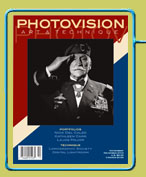![]()
| By: Robert Hirsch From Vol. 1 No. 2 In My Opinion |
7. What makes a photograph interesting?
A significant ingredient that makes a photograph interesting is empathy for it gives viewers an initial path for cognitive and emotional comprehension of the subject. Yet the value of a photograph is not limited to its depiiction of people, places, things, and feelings akin to those in our life. An engaging image contains within it the capacity to sensitize and stimulate our latent exploratory senses. Such a photograph asserts ideas and perceptions that we recognize as our own but could not have given concrete form to without having first seen that image.
8. How is meaning of a photograph determined?
Meaning is not intrinsic. Meaning is established through a fluid cogitative and emotional relationship among the maker, the ppphotograph, and the viewer. The structure of a photograph can communicate before it is understood. A good image teaches one how to read it by provoking responses from the viewersí inventory of life experiences as meaning is not always found in things, but sometimes between them. An exceptional photograph creates viewer focus that produces attention, which can lead to definition. As one mediates on what is possible, multiple meanings may begin to present themselves.
9. Are the issues surrounding truth and beauty still relevant to photographers of the 21st century?
During the past twenty-five years issues of gender, identity, race, and sexuality have been predominant because they had been previously neglected. In terms of practice, the artistic ramifications of digital imaging have been a overriding concern. But whether an imagemaker uses analog silver-based methods to record reality or pixels to transform it, the two greatest issues that have concerned imagemakers for thousands of years - truth and beauty - have been conspicuously absent from the discussion. In the postmodern era irony has been the major form of artistic expression.
Although elusive, there are certain patterns that can be observed that define a personal truth. When we recognize an individual truth it may grab hold and bring us to a complete stop - a total mental and physical halt from what we were doing, while simultaneously experiencing a sense of clarity and certainty that eliminates the need for future questioning.
Beauty is the satisfaction of knowing the imprimatur of this moment. Although truth and beauty are based in time and may exist only for an instant, photographers can capture a trace of this interaction for viewers to contemplate. Such photographs can authenticate the experience and allow us to reflect upon it and gain deeper meaning.
Beauty is not a myth, in the sense of just being a cultural construct or creation of manipulative advertisers, but a basic hardwired part of human nature. Our passionate pursuit of beauty has been observed for centuries. The history of ideas can be represented in terms of visual pleasure. In pre-Christian times Plato stated: “The three wishes of every man: to be healthy, to be rich by honest means, and to be beautiful.” More recently American philosopher George Santayana postulated that there must be “in our very nature a very radical and widespread tendency to observe beauty, and to value it.”
10. How has digitalization effected photography?
Although Photovison is “dedicated to the pure craft of photography," digitalization has shifted the authority of the photograph from the subject to the photographers by allowing them to extend time and incorporate space and sound. Photography is no longer just about making illusionistic windows of the material world or collapsing events into single moments. The constraints on how a photograph should look have broken down, they no longer have to be two-dimensional objects that we look at on a wall. This elimination of former artificial barriers is also good for those who wish to practice the art and craft of photography because it encourages makers to open the doors of perception to new ideas and methods for making photographs.
11. What are the advantages of digital imaging over silver-based imagemaking?
As in silver-based photography, digital imaging allows truth to be made up by whatever people deem to be important and whatever they choose to subvert. While analog silver-based photographers begin with "everything" and often rely on subtractive composition to accomplish these goals, digitalization permits artists to start with a blank slate. This allows imagemakers to convey the sensation and emotional weight of a subject without being bound by its physical conventions, giving picturemakers a new context and venues to express the content of their subject.
12. What are the disadvantages of digital imaging?
The vast majority of digital images continue to be reworkings of past strategies that do not articulate any new ideas. Manufacturers promote the fantasy that all it takes to be an artist is just a few clicks of a mouse or applying a preprogrammed Fresco or Van Gogh filter. The challenge remains open: to find a native syntax for digital imaging. At the moment, this appears to be one that encourages the hybridization and commingling of mediums.
On the practice side, having a tangible negative allows one to revisit the original vision without worrying about changing technology. One could still take a negative that William Henry Fox Talbot made to produce his first photographic book, The Pencil of Nature (1843 - 1846), and make a print from it today. In 150 years will there be a convenient way for people to view images saved only as digital files? Or will they be technically obsolete and share the fate of the 8-track audio tape or the Beta video system of having data that most people can no longer access?
One does not have to be a Luddite to continue making analog prints. One reason to keep working in a variety of analog processes is that digital imaging tends to physically remove the maker from the photographic process. This is not a romantic notion or a longing of nostalgia for the ways of the past. What often lost is the pure joy of the atmospheric experience of being alone in a special dark room with an orange glowing light. The exhilaration of being physically creative as your body and mind work together to produce a tangible image. The making of an analog photograph is a haptic experience that does not occur while one is seated in a task chair. The smell of chemicals, the sensory experiences of running water as an image emerges in the developing tray from a white nothingness. A silver-based photograph never looks better than when viewed when it is glistening wet from its final wash. And regardless of how long one has been making prints in the darkroom, there is still that small thrill that your photograph “has come out” and now can have a life of its own.
To be continued…
Robert Hirsch’s latest book Seizing the Light: A History of Photography is published by McGraw-Hill (www.mhhe.com/museum). Hirsch will be teaching an online history of photography course this January for college credit. For information visit www.enmu.edu/photohistory. Hirsch is also the author of Exploring Color Photography, third edition also published by McGraw-Hill and is currently working on a revised and expanded second edition of Photographic Possibilities: The Expressive Use of Ideas, Materials, and Processes published by Focal Press (www.focalpress.com). He is on the art faculty of the State University of New York at Buffalo and will be teaching History of Photography this fall. His photographs were most recently shown at Stefan Stux Gallery in New York. They are also featured in the current Light Work Annual/Contact Sheet 107 with an essay by Jeffrey Hoone, Director of Light Work, Syracuse, NY (www.lighwork.org).


